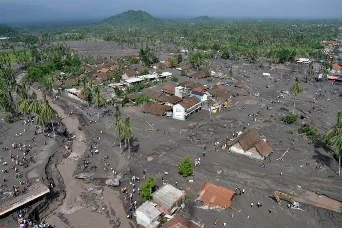 Vast torrents of volcanic mud washing down the slopes of Mount Merapi have destroyed or damaged more than 600 homes over the past few days, an official said on Sunday.
Vast torrents of volcanic mud washing down the slopes of Mount Merapi have destroyed or damaged more than 600 homes over the past few days, an official said on Sunday.
Heri Prawoto, head of the Magelang Disaster Mitigation Office in Central Java, said 106 homes had been destroyed by the mud flow, or lahar. Another 323 have suffered heavy damage, 105 moderate damage and 91 light damage.
He added that another 11 houses were at risk.
Salam, where 413 of the 625 damaged homes are located, has been the worst-effected subdistrict, Heri said.
The lahar has also destroyed 11 bridges, damaged four others and cut off three roads.
It has left more than 3,400 people living in temporary shelters, five months after Merapi began its biggest eruption in a century.
Heri said the lahar was being fed by vast quantities of volcanic ash washed by heavy rain into the Putih and Pabelan rivers, which dumped it downstream on the affected communities.
He added that authorities had been trying to ease the problem by dredging the rivers using heavy equipment, and by building levees to stop the rivers bursting their banks.
However, many of the levees have proven too weak in the face of the lahar.
Sungkono, head of Jumoyo village in Salam subdistrict, said the authorities had been using the mud dredged from the rivers to build up the levees.
“What they should do is cart that mud away so that there’s no possibility of it washing back into the rivers when it rains,” he said.
In neighboring Sleman district, in Yogyakarta, officials have announced that they will build new homes for those who lost theirs to the lahar.
District chief Sri Purnomo said new houses for people left homeless by Merapi’s devastating October eruptions had been completed this month.
“At the moment, the new houses are being prioritized for the survivors of the eruptions,” he said on Saturday.
“Victims of the lahar will get new shelters in the second phase of building [to begin in April].”
The lahar that hit Sleman this week flowed down the Opak and Gendol rivers, destroying homes in at least two villages.
Surono, the head of the Volcanology and Geological Disaster Mitigation Agency, said the torrents of mud would continue to pose a serious threat for at least the next four years.
He said last year’s eruptions deposited an estimated 150 million cubic meters of ash and rock across Merapi’s slopes. It is estimated that more than two-thirds of that remains on the mountain.
Yogyakarta Mayor Herry Zudianto said on Sunday that his administration had been forced to extend the emergency period announced after the eruptions from the end of March to the end of April to deal with the lahar.
He blamed the unseasonably heavy rains that are washing the volcanic ash into the Code River.
The lahar there has damaged or destroyed around 1,000 homes this month alone.
The local office of the Meteorology, Climatology and Geophysics Agency has predicted the rainy season will end in April.


